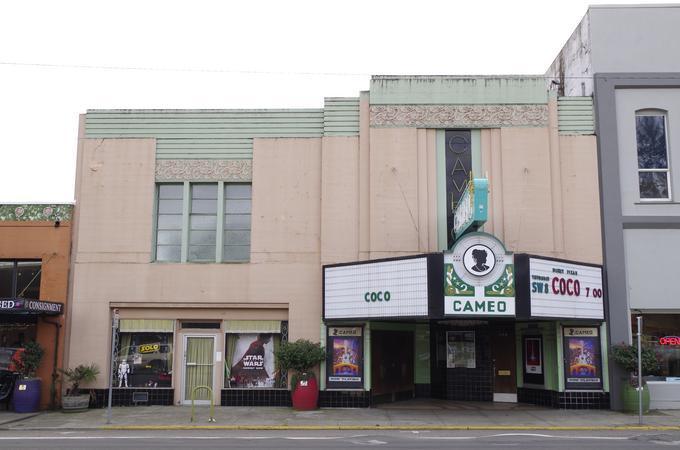Cameo Theatre (Newberg, Oregon)
- Title
-
Cameo Theatre (Newberg, Oregon)
- LC Subject
-
Architecture, American
Historic buildings
- Creator
-
Hilborn, Day W., 1897-1971
Fritsch, Margaret G., 1899-1993
- Photographer
-
Grilc, Brandon J.
- Description
-
Built in 1936-1937, the Cameo Theatre is located at 304 E First Street in the historic City Center/Downtown neighborhood of Newberg, Yamhill County, Oregon. The building is located within a commercial setting surrounded by restaurants, retail stores, and other small businesses. The Cameo Theatre is a two-and-onehalf-story building designed by Day W. Hilborn and Margaret Goodin Fritsch with prominent Art Deco and Streamline Moderne architecture features, such as its smooth concrete exterior walls, asymmetrical facade,geometric lines, grouped windows, and slight vertical projection above the roof line. Other typical Art Deco and Streamline Moderne features displayed on the Cameo Theatre include low-relief decorative panels, horizontal grooves, pigmented structural glass (Carrara glass), and stainless steel trim. The building was constructed by Peter Johnson and the Johnson Construction Company of Vancouver, Washington, out of board-formed reinforced concrete, which extended below grade creating a full-height partial basement. Theprimary (north) facade consists of a recessed entry under a project ing marquee to the west and a recessed storefront bay to the east at the ground floor. The second floor consists of the projecting bay above the primary entrance and a set of vertical windows to the west. Although the primary facade displays two separate entrances, the theatre building is one volume. The remaining elevations, where exposed, are unfinished and lack architectural detail. Although the theatre retains its original exterior configuration and form, alterations have been made to the main entrance, marquee, and storefront. However, much of its original Art Deco and Streamline Moderne architectural details remain present. The interior of the Cameo Theatre is planned around the 350-seat , two-story-volume, German-inspired auditorium with its sloping floor, two-aisle seating arrangement, and interior decorations. In plan, the interior of the theatre consists of the foyer, snack bar, and stairs to the north, the centrally located auditorium, and the proscenium stage and fly tower to the south at the ground floor. The second floor includes the lounge, current projection room (modified from original lounge corridor and usherette room), toilet rooms, and office to the north, and the second-story volume of the auditorium and fly tower to the south. The original projection room and attic are located above the current projection room on the second floor. The basement is below the proscenium stage and fly tower. The interior walls are constructed out of board-formed reinforced concrete and are primarily finished with plaster and stucco by H. G. Gosney of Portland, Oregon. The theatre retains its original paint scheme of light greens, pinks, and reds displayed in the acoustical fabrics, curtains by Charles Ammon Co. of Portland, Oregon, and replaced period-style interior carpet.8 Interior Art Deco and Streamline Moderne stylistic details include curved walls, geometric Art Deco lighting fixtures and signage, low-relief decorative panels , vertical and horizontal semi-cylindrical reeded moulding, and decorative castmetal chair side panels. Although the theatre retains much of its original details and aesthetic, there have been alterations to its interior configuration and seating. Overall, the Cameo Theatre retains integrity of location, setting, design , materials, workmanship, feeling, and association. The building remains in its originall location within the downtown Newberg setting, which includes a streetscape and buildings that represent the city's early 20th century infrastructure and business development. The theatre conveys its overall design and retains character-defining materials and features that display the building's construction and workmanship. The theatre's operation under long-term owner Ted Francis and continued use since 1937 convey the building's integrity of feeling and association. Several minor and few moderate alterations to exterior and interior features are noted in the nomination, but these do not inhibit the building's overall integrity or its ability to convey the theatre's historic significance .
- View
-
exterior: north facade, looking south
- Style Period
-
Art Deco
Streamlined Moderne
- Location
-
Newberg >> Yamhill County >> Oregon >> United States
- Date
-
1937
- View Date
-
2017-12-12
- Identifier
-
OR_YamhillCounty_CameoTheater_0001
- Rights
-
In Copyright - Educational Use Permitted
- Dc Rights Holder
-
Oregon. State Historic Preservation Office
- Source
-
Oregon. State Historic Preservation Office
- Type
-
Image
- Format
-
image/tiff
- Measurements
-
5150 square feet
- Material
-
concrete, thermoplastic membrane
- Set
-
Building Oregon
- Primary Set
-
Building Oregon
- Institution
-
University of Oregon
- Citation
-
Oregon State Historic Preservation Office, Oregon State Historic Preservation Office, http://www.oregon.gov/OPRD/HCD/SHPO/
